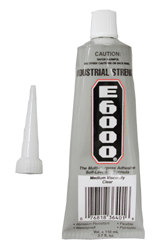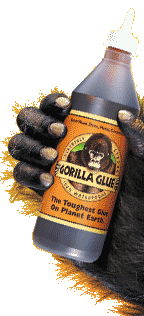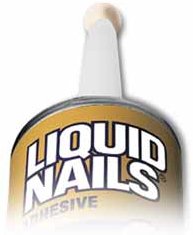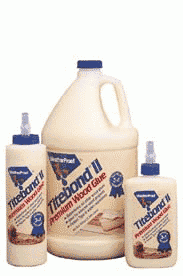

|

|
Scratch & Bash
:
How-to's
Useful Adhesives in Large Scale
Jul 11, 2007


By Rick Henderson
LSOL.com Associate Editor |
Author
Bio
There are many adhesives on the market, but there is no one glue for every situation. Keeping a variety of fresh glues on hand will be helpful. Come learn what to use when and how to best use it!
|
Useful Adhesives in Large Scale By Rick Henderson | There are many adhesives on the market, but there is no one glue for every situation. Keeping a variety of fresh glues on hand will be helpful. Like food products however, almost all glues do have a limited shelf life, so make sure what you are buying has not been in the store a long time. And if you have had it a few years, it may not work as well. Is it glue or adhesive? If you want to get unnecessarily technical, glues are categorized as deriving from natural polymers and adhesives are generally chemically synthesized polymers. You will find both names, but for the G-gauge modeler that is not also a rocket scientist, either is appropriate to describe the bonding agents. We will try to stick with the commonly used glues for G-gauge. Before we wander off into the variety of glues available, it is important to understand that most glues come with a toxic warning and it is important to follow the Health and Safety advice. If it says "use in well ventilated place", then make sure you have an airflow away from you to the outside. As an added safety issue, if your working with the super fast glues, have a de-bonding agent handy so you can unglue your fingers, in the event the glue sticks a little more than expected. Some people will even want to wear gloves when handling some fast acting glue products. I also have to mention that smoking or using open flames around some adhesives may turn your project and portions of yourself into ash. Read the warning label. Also on that label, you will often find information about the best environment to use the glue in. Try to comprehend this, as most glues don't bond well on dirty surfaces outside in a cold rain. If you want your adhesive to hold, take the time to do it right. Prepare the surface in the suggested environment, which usually includes a working temperature range in a dry place on clean surfaces.
There are two common glue failures to consider. Using the wrong glue for the material and not giving the glue adequate time to dry before handling the item. Again, the label will tell you what the glue works on and how long it takes to dry. If your glue takes hours to dry, go to another project and let this one set. And don't come "test" its drying progress until the entire time has passed. A good Web site for selecting the proper adhesive to bond two different types of material together is This to That, which covers 11 different materials and the type of glue to bond each together. While a few models in G-gauge work best with specially formulated glues, often your best bet is to go to a well-supplied store such as Lowe's and select from what they have on hand. Warning, there may be over a 1000 varieties to choose from so don't be afraid to ask for help. You also can't simply buy glue by the brand name any more as most brands offer a varying line of adhesives. Many years ago we used Testors cement to build our plastic models but today, Testors offers 23 different finishing adhesives and container sizes. And since we will be working with our model outdoors, we are way beyond the old stand-by, Elmer's White Glue, an indoor craft product. Since many structures on G-gauge railroads stay outside year round, most of your adhesives need to be able to withstand the environmental changes they will encounter. Some glues will not hold up in extreme cold or constant humid environments. Again read the labels. When you are using a new glue for the first time, or on a new material, it is best to try a test on some scrap material that you will toss anyway. This allows you to learn how the glue reacts on the material and if it is right for the job. For example if you want to add a wood sign to a plastic building wall, glue a similar piece of wood to the scrap plastic spur that the structure parts came on and observe what effects the glue has on each material. Some glues work by actually melting away the plastic surface to make a strong bond at the joint, but this may have an adverse effect on your piece of wood, or it may not hold at all.
Also a note about material finish; if you are gluing a painted piece of wood to a painted metal post, you are in essence gluing two painted surfaces and the glue will eventually react to the paint causing your adhesive joint to fail. Clean the paint off to expose each bare surface of the material. Below are some of the adhesives known to work outdoors in Large Scale Model Railroading. There are others, but these are the ones you can easily find. I tried to exclude adhesives that may have a short life span in the great outdoors. It is not good for a great glue to fail after only a couple of years and have your hard efforts fall apart.  | E6000 A special formulation adhesive and sealant for working with industrial strength requirements. It adheres to most woods, metals, concrete, masonry, ceramics, rubbers, glass and plastics, It is abrasion resistant, waterproof, flexible, and may be painted. Best to apply with a plastic tip, sold separately. Once allowed to dry it is very strong. |
 | Gorilla Glue is a strong and versatile adhesive. It takes very little to cover a large surface. It is 100% waterproof, and bonds wood, stone, metal, ceramics and a few other materials. When using, you moisten one surface and apply the glue sparingly to the other surface and clamp the two together for 1-4 hours. You should read all of the label to see if it fits your needs. |
 | Liquid Nails is a brand name, not a single item. Liquid Nails has a large line of products and each is specially formulated to bond various surfaces. Good ventilation is necessary when using. Liquid Nails products should be applied between the temperatures of 40?F to 90?F and should be allowed to dry overnight. You actually have up to 15 minutes working time with most of this line, which may be too long for some applications. While this adhesive is water resistant it will remain somewhat flexible once dry. |
Piko & Pola Glue come in the Piko and Pola structures. It is their own brand of glue which is excellent for their heavy plastics. While there usually is just enough to finish the structure it comes with, additional tubes can be found on the Internet if your local retailer does not carry it. Search Pola #330592 or PIKO #55700.  | Tite-Bond Original Wood Glue is known as the standard for woodworking and the product line has expanded into many specialty adhesives. However, this is not a glue of choice for outdoor applications. Titebond II is best for water-resistance exterior woodworking projects outdoors. It has a strong initial tack, fast set up, superior strength and is sandable. You will find a large line of Tite-Bond adhesives in stores. |
CA or Super Glues are a class of fast acting strong adhesives that work very well in applications where you are working with small or lightweight items such as details. I have found that these work best on wood-to-wood applications. It does work on other material, but the surfaces usually need to match exactly to get a good bond.
Silicone adhesives are commonly known as silicone sealers. While they are waterproof, they have poor actual adhering properties. Painting over a silicone adhesive may even cause it to break its seal. The silicone adhesive GOOP is an advancement and even comes UV resistant. However, it has a relatively short life span outdoors. Epoxy adhesives are created by mixing resin and hardener components equally together to produce a chemical reaction to form high strength bond. While some materials or instructions may call for epoxy, in today's expanding line of adhesives for outdoor use, you may never find you need to use them. Glue guns, hot, cold or multi-temperature may be somewhat useful during construction when used to temporarily tack parts together for fitting. Then you use your permanent adhesive once your satisfied the joint position is correct. Hot glues will not generally hold up well outdoors. Okay, now all you need to do is decide what you want to build and take the time to read the directions on the adhesive you need to build your project with. Most important, once you glue something, give it all the time it needs to set up and cure before playing with it. Top of Page
|
|

|
IMPORTANT LINKS

Get Your Official Diploma

Watch New Videos


New Products Online
|
|
|

|



